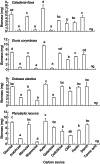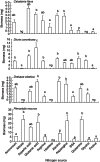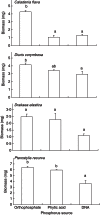Variation in nutrient-acquisition patterns by mycorrhizal fungi of rare and common orchids explains diversification in a global biodiversity hotspot
- PMID: 23532043
- PMCID: PMC3662510
- DOI: 10.1093/aob/mct064
Variation in nutrient-acquisition patterns by mycorrhizal fungi of rare and common orchids explains diversification in a global biodiversity hotspot
Abstract
Background and aims: Many terrestrial orchids have an obligate requirement for mycorrhizal associations to provide nutritional support from germination to establishment. This study will investigate the ability of orchid mycorrhizal fungi (OMF) to utilize a variety of nutrient sources in the nutrient-impoverished (low organic) soils of the Southwest Australian Floristic Region (SWAFR) in order to effectively compete, survive and sustain the orchid host.
Methods: Mycorrhizal fungi representing key OMF genera were isolated from three common and widespread species: Pterostylis recurva, Caladenia flava and Diuris corymbosa, and one rare and restricted species: Drakaea elastica. The accessibility of specific nutrients was assessed by comparing growth including dry biomass of OMF in vitro on basal CN MMN liquid media.
Key results: Each of the OMF accessed and effectively utilized a wide variety of nutrient compounds, including carbon (C) sources, inorganic and organic nitrogen (N) and inorganic and organic phosphorus (P). The nutrient compounds utilized varied between the genera of OMF, most notably sources of N.
Conclusions: These results suggest that OMF can differentiate between niches (micro-niche specialization) in a constrained, highly resource-limited environment such as the SWAFR. Phosphorus is the most limited macronutrient in SWAFR soils and the ability to access phytate by OMF indicates a characterizing functional capacity of OMF from the SWAFR. Furthermore, compared with OMF isolated from the rare D. elastica, OMF associating with the common P. recurva produced far greater biomass over a wider variety of nutritional sources. This suggests a broader tolerance for habitat variation providing more opportunities for the common orchid for recruitment and establishment at a site.
Keywords: Carbon; Ceratobasidium; Sebacina; Tulasnella; nitrogen; nutrients; orchid mycorrhizal fungi; phosphorus; soil; terrestrial orchid.
Figures



Similar articles
-
Mycorrhizal preference promotes habitat invasion by a native Australian orchid: Microtis media.Ann Bot. 2013 Mar;111(3):409-18. doi: 10.1093/aob/mcs294. Epub 2012 Dec 28. Ann Bot. 2013. PMID: 23275632 Free PMC article.
-
Differences in carbon source utilisation by orchid mycorrhizal fungi from common and endangered species of Caladenia (Orchidaceae).Mycorrhiza. 2017 Feb;27(2):95-108. doi: 10.1007/s00572-016-0732-1. Epub 2016 Sep 17. Mycorrhiza. 2017. PMID: 27639577
-
Inorganic phosphorus nutrition in green-leaved terrestrial orchid seedlings.Ann Bot. 2022 May 12;129(6):669-678. doi: 10.1093/aob/mcac030. Ann Bot. 2022. PMID: 35247265 Free PMC article.
-
Terrestrial orchid conservation in the age of extinction.Ann Bot. 2009 Aug;104(3):543-56. doi: 10.1093/aob/mcp025. Epub 2009 Feb 14. Ann Bot. 2009. PMID: 19218582 Free PMC article. Review.
-
Mycorrhizal fungi affect orchid distribution and population dynamics.New Phytol. 2018 Sep;219(4):1207-1215. doi: 10.1111/nph.15223. Epub 2018 May 23. New Phytol. 2018. PMID: 29790578 Review.
Cited by
-
Mycorrhizal Fungal Partners Remain Constant during a Root Lifecycle of Pleione bulbocodioides (Orchidaceae).J Fungi (Basel). 2021 Nov 22;7(11):994. doi: 10.3390/jof7110994. J Fungi (Basel). 2021. PMID: 34829281 Free PMC article.
-
Limited efficacy of a commercial microbial inoculant for improving growth and physiological performance of native plant species.Conserv Physiol. 2024 Jun 18;12(1):coae037. doi: 10.1093/conphys/coae037. eCollection 2024. Conserv Physiol. 2024. PMID: 38894755 Free PMC article.
-
Host population size is linked to orchid mycorrhizal fungal communities in roots and soil, which are shaped by microenvironment.Mycorrhiza. 2021 Jan;31(1):17-30. doi: 10.1007/s00572-020-00993-5. Epub 2020 Oct 28. Mycorrhiza. 2021. PMID: 33113039
-
Co-Cultures of Mycorrhizal Fungi Do Not Increase Germination and Seedling Development in the Epiphytic Orchid Dendrobium nobile.Front Plant Sci. 2020 Oct 22;11:571426. doi: 10.3389/fpls.2020.571426. eCollection 2020. Front Plant Sci. 2020. PMID: 33193505 Free PMC article.
-
Fungal symbionts may modulate nitrate inhibitory effect on orchid seed germination.Mycorrhiza. 2021 Mar;31(2):231-241. doi: 10.1007/s00572-021-01021-w. Epub 2021 Jan 25. Mycorrhiza. 2021. PMID: 33492496
References
-
- Alexander C, Alexander IJ, Hadley G. Phosphate uptake by Goodyera repens in relation to mycorrhizal infection. New Phytologist. 1984;97:401–419.
-
- Antibus RK, Sinsabaugh RL, Linkins AE. Phosphatase activities and phosphorus uptake from inositol phosphate by ectomycorrhizal fungi. Canadian Journal of Botany. 1992;70:794–801.
-
- Arditti J. Factors affecting the germination of orchid seeds. The Botanical Review. 1967;33:1–96.
-
- Bartlett EM, Lewis D. Surface phosphatase activity of mycorrhizal roots of beech. Soil Biology and Biochemistry. 1973;5:249–257.
-
- Batty AL, Dixon KW, Brundrett MC, Sivasithamparam K. Orchid conservation and mycorrhizal associations. In: Dixon KW, Barrett RL, editors. Microorganisms in plant conservation and biodiversity. Dordrecht: Kluwer Academic Publishers; 2002.
Publication types
MeSH terms
Substances
LinkOut - more resources
Full Text Sources
Other Literature Sources

